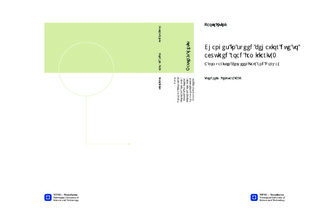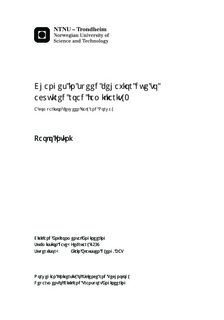| dc.description.abstract | Study of traffic safety related problems concerns a lot of topics and some of them are not related only to engineering. In order to analyze accident causes it is important to comprehend the influence of human factors, as stated in most papers found in recent literature.I analyzed three areas related to human factors: risk perception, driving behaviour and speed choice. These topics are related with one another: speed choice depends on risk perception and it is involved in some driving behaviours. Instead, literature is poor of works about influence of memory on driving behaviour, even if in some applications it is important to know driving habituation related factors.Road users could be divided in: regular users (mainly commuters) and recreational users (people who have no confidence with the route). For example, differences between them are considered in a formula used for calculating capacity and level of service of a given road (HCM 2000). In this formula, there is a coefficient which assumes different values according to the expected percentage of recreational user in traffic flow. However, in literature, it is not possible to find accurate studies about dividing drivers into recreational and regular users and about the influence of these differences on driving behaviour. In order to understand those matters, the first step consists in analyzing process which leads a recreational user to become a regular one: drivers learning process must be understood.Hypothesis is that learning process brings users to a condition of habituation and, ways in which risk perception and speed choice are influenced by habituation have to be inquired. Reaching the habituation condition is related, in psychology, to the number of repetitions of the same stimulus. After being exposed to same stimulus, people tend to decrease response to that stimulus over time. Trying to apply these concepts to drivers, a user who usually drive on a given road in the same conditions, should decrease response to external stimulus over time. In this case, decreased response could be connected to a lowered target level of risk and an increasing of speed over time. In order to inquire about this phenomenon, a road experimentation involving a sample of 19 users was made in Italy, by collecting speed measurements employing GPS technology. Driving tests were repeated according to this schedule: first four tests four days in a row, fifth test after nine days from the first and the last test after twenty-six days from the first. Drivers were divided into risk categories (risky, prudent, variable) according to distance of their measured speed from mean speed. Furthermore, according to stopping sight distance diagrams, it was possible to divide road sections into visibility categories. Therefore, speed data were processed by considering three diverse drivers categories: risky (speed higher than the mean speed in at least five days out of six), prudent (speed lower than the mean speed in at least five days out of six), variable (speed varying around the means speed); four different visibility conditions: low (0 100 m), medium-low (100 200 m), medium (200 400 m), high (400 600 m); six different test days (day 1, day 2, day 3, day 4, day 5, day 6). Results of Italian experimentation are explained as follows: speed linearly increases in going from low visibility sections to higher visibility sections for all drivers; speed increases over the first four days and after tends to remain almost the same. Therefore, a learning process could be noted in the speed increasing over time. However, dividing drivers into risk categories allows us to appreciate two different trends: risky users tend to maintain their speed on the same level after fourth day; prudent users, instead, decrease their speed in fifth day (after five days without driving on that road). Hence, it seems that prudent users lose part of their acquired familiarity and part of the habituation effect by decreasing again speed. Risky users, instead, seem to maintain acquired familiarity even if there was a gap of five days between fourth and fifth test day. It could be suggested that a short memory effect and its efficient transformation in long term memory can be noted for risky users. Instead, it could be stated that prudent users need another test in order to reach the conversion of short term memory in long term memory. Furthermore, in long term, it seems that prudent users behaviour asymptotically tend to that one of risky users. The same experimentation was made on a sample of 10 users in Norway. Classification, analysis and data elaboration are the same of the Italian experimentation. However, a difference is the diverse employed GPS instrumentation: in the Norwegian experiment it has got a minor accuracy. Another difference is related to the route chosen for the experimentation: Norwegian route is more winding and characterized by a lower average visibility than the Italian one. Results of the Norwegian experimentation are explained as follows: speed increases in going from low visibility sections to higher visibility sections for all drivers; speed does not increase over time. It could be said that in the Norwegian experimentation it is not possible to appreciate the habituation effect but, actually, there are a lot of confounding factors which makes the comparison difficult. First confounding factor is related to employed instrumentation: uncertainty connected to measures could be too much high and so it could be not possible to appreciate speed changes over days. Second factor is route-related: the very winding Norwegian route could have limited drivers speed choice. Third factor is weather-related: the very variable Norwegian weather had a not negligible influence on speed choice, probably preventing habituation development. In fact, in order to reach the habituation, it is necessary that stimulus is always the same over time. Last noticed factor is culture-related: Italian drivers seem to show a higher speeding attitude than the Norwegian ones, even if comparison is difficult because of differences between the two roads. All these highlighted factors, mixed together, have a great influence on trying to make a comparison between the two experiments because it is not easy to understand the influence of each factor by itself. Therefore, in order to observe habituation to drive effect, experiments should be repeated by employing same instruments and comparable road, weather and traffic conditions. However, Norwegian experiment (as it can be seen also in ANOVA analyses) gives a proof that there is a strict connection between speed and visibility. Hence, employed analysis method could be used also for future works. Finally, some models were proposed by using risk classes based on self-reported speeding attitude visibility classes and time as speed predictors. Basically, results show that other variables have to be added in order to get more reliable models. This goal will be a challenge for future works. | nb_NO |

